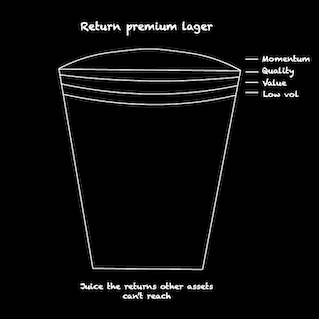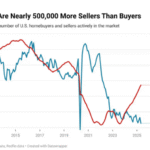
Do the quality, momentum, low vol, and dividend growth strategies beat the market?
Few investors would say “no” to beating the market. Even the most passive among us would happily filter-feed a few extra quid – like a financial blue whale – if we didn’t need an ‘edge’ to make it happen.
Last week we looked at one way to potentially do that. The small value strategy has earned a 2% annualised premium versus the market over the long-term. Outside the US, small value has beaten the market by 1.5% annualised since 1990. Which is just as well, because it’s had a torrid time against the S&P 500 these past 20 years.
But other systematic market-beating strategies are available!
The cast of credible candidates includes:
- Momentum – You buy recent winners, sell recent losers
- Quality – Firms with high return on equity, low debt, and stable earnings growth
- Low volatility – Low beta stocks that don’t fizz or fizzle as violently as the market. The draw here is the potential for superior risk-adjusted returns
We can invest in any of these strategies using an ETF, they’re backed by independent research, and the risks are pretty well understood.
But how well do they actually work? If in fact they do…
Are there any diversification benefits to be had if you combine the strategies?
Let’s turn to the data!
While we’re at it, let’s look at the dividend growth / leader / aristocrats strategy, too. Dividend growth is not widely considered to be a market-beating wheeze but we have the numbers, so let’s see.
Investing returns sidebar – All returns quoted are nominal total returns. US data is from the astounding Simba’s backtesting spreadsheet and compiled by members of the Bogleheads to further public knowledge of investing. World data is quoted in GBP and is from the spiffing justETF.
Market beat-’em-up
Which strategies socked it to the market over the longest comparable timeframe?
Here’s our contenders’ annualised returns versus the S&P 500 for the 40 years from 1985-2024:
| Strategy | Annualised return (%) | Sharpe ratio |
| Broad market (US) | 11.7 | 0.69 |
| Momentum | 13.7 | 0.71 |
| Quality | 12.9 | 0.72 |
| Dividend growth | 12.4 | 0.88 |
| Low volatility | 11.1 | 0.84 |
| Small value | 11.1 | 0.63 |
| Small cap | 10.5 | 0.58 |
US stocks only. USD returns. Small value and small cap included for comparison purposes.
The Sharpe ratio is a measure of risk-adjusted returns. Higher is better.
On these numbers momentum looks like a must-have.
That’s not too surprising. The long-short version of the momentum strategy stands out as the most profitable of the so-called risk factors in academic literature. And here we can see that a long-only iteration has delivered a 2% premium in the all-important US market.
Moreover, my numbers (not tabulated) show momentum’s volatility is pretty normal for an equity holding. Volatility averages 19.3% across the period.
Also-rans worth running
What about our other belligerents?
Quality also looks good. It beat the market by 1.2% per year on average. That will add up. Again there’s no sign you must endure sickening volatility to snaffle the extras.
The biggest surprise to me is dividend growth. High dividend stocks are routinely found by academics to lack any special sauce. But the strategy has topped the market by a commendable 0.7% over the period we have data for.
Dividend growth also delivered the best risk-adjusted returns. That is, you got more bang for your buck per unit of risk taken (as measured by volatility).
Low volatility didn’t beat the market but it isn’t meant to. A low volatility strategy touts superior risk-adjusted returns versus the broad market – and on that score, it delivered.
You might think of low vol as the antacid of equity strategies. It offers relief against stomach-lurching drawdowns without sacrificing too much return.
Finally, small value and small cap were poor over this time horizon. But if that encourages you to write-off small value then I’d urge you to read our recent musings on small caps first.
Time trial
Let’s split apart the 40-year timeframe. Doing so may reveal extra nuance:
| Strategy | 5yr ann return (%) | 10yr ann return (%) | 15yr ann return (%) | 20yr ann return (%) | 25yr ann return (%) | 30yr ann return (%) |
| Broad market | 14.5 | 13.1 | 13.8 | 10.3 | 7.7 | 10.9 |
| Momentum | 11.8 | 13.2 | 14.5 | 11.1 | 8.6 | 13.2 |
| Quality | 13.6 | 12.9 | 13.8 | 10.8 | 8 | 12 |
| Divi growth | 11.5 | 11.4 | 12.3 | 9.7 | 9.6 | 11.1 |
| Low volatility | 8.1 | 10.2 | 12.1 | 9.5 | 11.1 | 10.1 |
| Small value | 9.9 | 8.9 | 11.2 | 8.5 | 9.8 | 10.7 |
| Small cap | 9.3 | 9.1 | 11.6 | 9.1 | 8.7 | 10.2 |
Firstly, we can see that none of this lot laid a glove on the S&P 500 these past five years.
Don’t bother with risk factors unless you’re prepared for the long haul. If they beat the market all the time, then they would stop being risk factors. The key word is risk.
With that said I’ve highlighted momentum because it’s the only factor that’s consistently beaten the US market across every timeframe beyond five years.
Quality has been more erratic – while you have to push your view back at least 25 years before dividend growth bests the S&P 500.
Timely reminders
The table shows how considering different time frames can influence our view. For example, low vol and small value would look pretty hot right now, if all we had to go on was 25 years worth of returns.
Is there anything special about this quarter-of-a-century mark?
Well, the broad market nose-dived 38% during the Dotcom Bust (2000-02). But low vol, small value, and dividend growth all climbed during the crash. They hedged your losses at just the right time.
Low volatility and dividend growth also suffered far less than the S&P 500 during the Global Financial Crisis and 2022’s inflationary surge. Meanwhile, small value enjoys a lower correlation with the market than the other strategies across the entire period.
So there is some strategic value in thinking beyond the raw returns, especially if your objective is to limit drawdowns.
For example:
- Want to curtail your losses in a crisis? Consider low volatility and dividend growth.
- Want to diversify your returns away from big tech? Think small value.
Incidentally, I find the risk factor framework more convincing than geography as a basis for diversification. Perhaps that’s one we can debate in the comments?
Diversification potential
A correlation matrix can help us assess the diversification benefits of each asset pair. The lower the number the better.
| Strategy | Broad market | Small value | Momentum | Quality | Low volatility | Divi growth |
| Broad market | 1.0 | 0.71 | 0.90 | 0.96 | 0.94 | 0.87 |
| Small value | 0.71 | 1 | 0.5 | 0.59 | 0.71 | 0.78 |
| Momentum | 0.90 | 0.5 | 1 | 0.91 | 0.86 | 0.75 |
| Quality | 0.96 | 0.59 | 0.91 | 1 | 0.90 | 0.85 |
| Low volatility | 0.94 | 0.71 | 0.86 | 0.90 | 1 | 0.92 |
| Divi growth | 0.87 | 0.78 | 0.75 | 0.85 | 0.92 | 1 |
Small value demonstrates the most diversification potential across the board. It’s the only strategy that’s not highly correlated with the broad market.
Even more intriguing is small value’s relatively low correlation with momentum and quality. That indicates these are likely complementary assets if you’re interested in a diversified multi-factor strategy.
Dividend growth also has some diversification value, so I’d also like to test how well it performs when paired with other strategies…
Multi-factor mash-up
Let’s dial up the fortunes of three equity portfolios:
- 50/50 momentum/small value (SCV) – best performer + most diversified
- 50/50 momentum/dividend growth – two strong performers + moderate diversification
- 50/50 dividend growth/small value – just to see!
Here’s the returns for each portfolio ranged against the market and their component strategies:
| Portfolio | 10yr ann return (%) | 15yr ann return (%) | 20yr ann return (%) | 25yr ann return (%) | 30yr ann return (%) | 40yr ann return (%) |
| 50/50 Mom / SCV | 11.2 | 13.1 | 10 | 9.5 | 12.3 | 12.7 |
| 50/50 Mom / Divi | 12.4 | 13.5 | 10.5 | 9.3 | 12.4 | 13.2 |
| 50/50 Divi / SCV | 10.1 | 11.8 | 9.2 | 9.8 | 11 | 11.9 |
| Broad market | 13.1 | 13.8 | 10.3 | 7.7 | 10.9 | 11.7 |
| Momentum | 13.2 | 14.5 | 11.1 | 8.6 | 13.2 | 13.7 |
| Small value | 8.9 | 11.2 | 8.5 | 9.8 | 10.7 | 11.1 |
| Divi growth | 11.4 | 12.3 | 9.7 | 9.6 | 11.1 | 12.4 |
The portfolios are rebalanced annually.
What I’m looking for from my backtest portfolios is only a modest reduction in long-term 40-year returns versus the strongest component in the mix.
I’d also like to see strong positive diversification potential at the 25-year mark. That’s the best period for getting a quick bead on the benefit of holding an otherwise weaker seeming asset.
I also want to check if holding two imperfectly correlated assets (for example momentum and small value) essentially delivers the market return. That is, do they just neutralise each other?
Not bad
The good news is that momentum and small value do not cancel each other out.
You still earn a 1% premium versus the market over the long-term, despite SCV’s poor showing overall.
The portfolio result also significantly improves on the performance of the market and momentum over 25 years – the period most affected by the background radiation of the Dotcom Bust.
Yes, you can rightly point out that small value has proved to be a drag overall. But you couldn’t have known that in advance.
Moreover, international small value has beaten the international market – even over the past five years. And it’s lagged international momentum by only 0.5% annualised over those last five years, too.
In other words we can’t conclude small value is dead (although it’s clearly resting in the US).
Dividend growth also proves out its diversification chops, while otherwise the numbers show what we already know – the strategy delivered strong returns over 40 years.
Beyond that, I don’t think there’s any point me torturing the data to find some mythical sweet spot involving, say, 17.37% of quality and eye of newt and whatnot.
Essentially, I just wanted to check that choosing moderately correlated factors can produce a diversification uptick without banjaxing the return premium.
If you don’t want to invest in something that hasn’t outperformed for the last ten years then fair enough. Stick to the market, I think that’s a perfectly rational place to be.
Show me the world
We can gain an alternative perspective by checking live fund data. A raft of World risk factor ETFs launched in Europe in 2015, so we can just about scrape up ten years worth of GBP returns by comparing them:
| Asset class | 5yr ann return (%) | 10yr ann return (%) | Sharpe ratio |
| Broad market | 12.4 | 12.6 | 0.79 |
| Momentum | 12.5 | 14.8 | 0.82 |
| Quality | 11.7 | 12.9 | 0.79 |
| Multi-factor | 11.6 | 11 | 0.69 |
| Low volatility | 6.9 | 9.9 | 0.76 |
| Small cap | 9 | 9.5 | 0.56 |
| Small value | 12.9 | 7.8 | – |
| Dividend growth | 8.3 | 7.2 | 0.48 |
Nominal total returns. ETF returns courtesy of justETF. 10-year return is actually 9-years and 9-months due to the youngest ETF’s inception date. Small value is DFA’s Global Targeted Value fund courtesy of Morningstar. Sharpe ratio is based on 10-year returns (not available for small value).
On this view, small value is the best performer over five years but the second worst over ten.
Momentum is the only strategy to beat the market convincingly over ten years.
Dividend growth had a particularly tough time of it.
What does this tell us?
- It’s been a great time to be a momentum investor
- Don’t believe small value is dead
- Don’t count on any strategy beating the market while you happen to hold it
- Don’t rely exclusively on return comparisons or the experience of a single market to form a view
Personally, before I commit a penny I want to read independent research that can offer:
- Some confidence the strategy will work in the future
- A guide to the risks
- A reason to believe this is more than just an eye-catching pattern in the data or a conveniently arranged backtest
Take it steady,
The Accumulator







